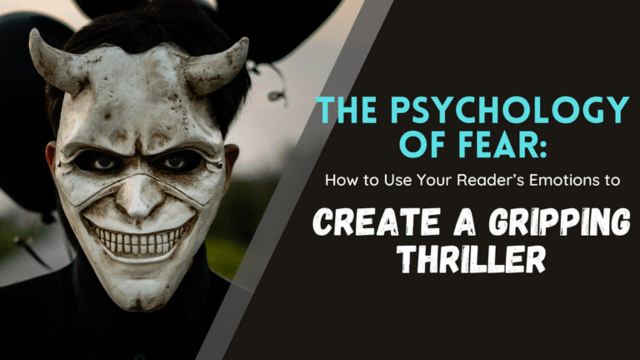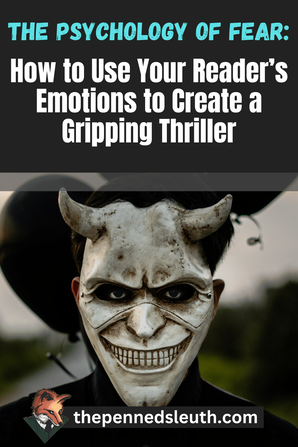Latest Writing Video! |
|
Whether you are writing a thriller short story or a thriller novel, you want to send a shiver down the reader's spine. No matter what fiction genre you are writing for, you want to evoke an emotional response, and for thriller novels, that is page-turning fear. That’s what I will be talking about today, explaining the science of fear in writing and giving you tips on how to spark it in your stories. Let’s dive in! Pin for LaterFear in WritingThere are many tools in writing that we use to elicit emotions from the reader. Have you ever wondered why some thriller stories keep you up at night, heart pounding and mind racing? It all comes down to the power of fear, a fantastic tool in writing. Writers have the ability to tap into the readers’ deepest fears and create a sense of unease that keeps them hooked until the very end. The art of crafting a gripping thriller lies in the ability to evoke intense emotions in the reader, as mentioned earlier, and psychology plays a crucial role in this process. By understanding how the human mind works, writers can create characters and situations that trigger deep-seated fears in readers. Drawing on psychological principles, such as the fear of the unknown, the fear of death, and the fear of loss, writers can craft stories that tap into universal human fears and keep the readers on the edge of their seats. The Science of FearNow, I am not a scientist, but I do understand some of the fundamentals of fears, and here are a few things I picked up with some research. Fear is a complex emotion that can take many forms, and different types of fear can have varying effects on the body and mind. For example, the fear of physical harm triggers the release of adrenaline, which can increase heart rate and blood pressure. Then there are more looked-over fears, like the fear of social rejection, which can also activate the same regions of the brain that are associated with physical pain. With that in mind, our fears and emotions can be directly influenced without actually being in those situations. For example, if you can imagine the sourest hard candy you know, covered in bitter, acidic lemon juice, you will find your mouth watering in anticipation of the sour taste. Your face might even contort imagining the moment it reaches your tongue! As writers, we need to get to the core of the emotions, the specific details that make something stressful, and threatening, and detail them in such a way that it hits the core fears of most thriller readers if not all of them. So, here are some tips for doing just that! Creating Fear in Your Story1. Tap into the Reader’s Imagination Fear is often rooted in the unknown, something that H. P. Lovecraft often worked with when it came to his cosmic horror stories. It stems from the idea that leaving certain details to the reader’s imagination can have them create a sense of uncertainty and unease. That’s why the fear of the dark is so common, it hides important information. If we hear a rustle in the bushes behind us, do we think nothing of it? Our survival instincts immediately jump into action, wanting you to pinpoint the source or run for the hills, because you don’t know if that rustle came from a rabbit hopping about or an unknown threat. Leave gaps in your details, the things left unsaid can often be the most terrifying, especially if the reader has an active imagination. 2. Use Sensory Details Writing that engages the senses can be incredibly powerful when it comes to creating fear. By describing what a character sees, hears, smells, tastes, and feels you can immerse readers in the story and get them into the same mindset your character has. Use these sensory details to evoke emotions like fear, tension, and anxiety. Now, this may require a bit of research and it pays to study how professionals pull it off in their novels, but you can also discover the sensory details by imagining yourself in an uncomfortable situation. That’s why so many writers suggest writing about what scares you, that way you have an easier time feeling the emotions and translating them into the story. 3. Establish a High-Stakes Situation Fear often arises from situations where there is a lot at stake, so create scenarios where the characters have a lot to lose. Whether it’s their own lives or the lives of their loved ones, make sure that the consequences of failure are dire. This will ratchet up the tension and keep readers engaged. It makes those tough decisions, such as whether to fight or run for the hills, all the more captivating! 4. Make the Villain Truly Terrifying Of course, if you plan to include a physical threat, an antagonist, in your thriller novel, you’re going to want to make sure they are truly terrifying. These scary qualities come in all forms. The antagonist might be a terrifying monster or an average person in the crowd, both are scary in their own ways. If you want to learn more about how to write an unforgettable antagonist, then check out my blog post on the topic, where I give a more in-depth look at the subject as well as some practical tips to keep in mind. 5. Use the Most Suitable Pacing The pacing of your story can have a big impact on how readers experience fear. For example, short, punchy sentences and paragraphs can create a sense of urgency. These are most commonly used in scenes where the character is running away from or fighting the threat. For slow pacing, the longer sentences and drawn-out paragraphs can create tension, which is fantastic for when you are slowly introducing the threat, creating uncertainty. If your character is hiding from the threat, or they are coming to realize there is a threat, then slow pacing can help you evoke the right emotions. Some Popular Fears to Play With
My ThoughtsWriting thrillers I have always found interesting. The balancing act of the pacing has always been the challenge more than anything else. When I get into the flow of writing, pacing tends to be the last thing on my mind and the words just flow. However, when a scene comes together, it’s really satisfying.
Of course, there is a lot more to writing a thriller than what I’ve talked about, so if you are an experienced writer, let me know your thoughts on the subject below! Thank you for reading and as always, Good day, goodnight, and happy writing!
0 Comments
Leave a Reply. |







